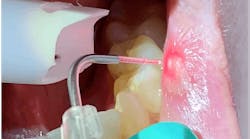I have been in the dental industry for more than 20 years, and one thing I know is that every office is striving for more new patients. We hope these new, warm bodies will have dental needs that will keep doctors and hygienists busy and productive. But how do we attract new patients? I am by no means a marketing specialist, so to answer that question you would need to talk to my good friend Rita Zamora. However, once you get those new patients into your practice, here are my three best practice management tips to give them a unique and inviting experience.
First — I’m huge advocate of “mapping” out the schedule. When an office tells me that they don’t have room for a new patient for at least six weeks, my response is, “That’s a good problem to have because it sounds like your office is busy, but you may be missing out on a golden opportunity if you’re unable to schedule the patient within 48 to 72 hours.” If you can schedule a new patient within 72 hours, he or she is less likely to hang up and call another practice. Also, the new patient will often tell his or her friends how easy it was to schedule an appointment in your office.
Whatever practice management software you’re using, find out how you can block out time for new patients. My recommendation is to block at least two spots per day (or whatever your office goal is for new patients) and put them in primetime locations. For most dental practices, these primetime spots are early morning and late afternoon. I’m not asking you to take out all your primetime spots for existing patients, so you might have to stagger them a little. Blocking out is the easy part ... the hard part is letting the blocks sit there empty. It takes a lot of discipline to not give that spot up to another patient who is begging for a 4 p.m. appointment on Friday afternoon. It also takes a lot of faith in your systems to be able to fill the new patient spots if they do not get filled. My recommendation is to leave the spots open until 48 hours before the appointment time, and then open them up to all patients. If you have patients on a waiting list, these would be my first calls, then start calling and moving patients forward from the schedule.
Second — Welcome your new patients to your practice. There are many ways to connect with new patients, and I don’t believe that one way is necessarily better than another. Patients need information such as new patient forms, directions, and office contact info. Our patients are using e-mail now more than ever, so sending an an e-mail welcome letter with a link to your website is a great way to provide this information. This will drive traffic to your website, where patients can find the new patient forms, contact info, and photos of your team. If you’re still using paper forms, I would suggest sending a welcome letter along with your new patient forms so the patient can be better prepared for his or her visit. People want to feel appreciated, and taking the time to send this valuable, yet simple packet shows your office takes the extra time to make sure they feel welcome.
Finally — The new patient is here for his or her first visit and your office prides itself in providing a thorough, comprehensive diagnostic appointment. Hopefully many patients may comment, “Wow, that was the most thorough exam I’ve ever had in a dental office.” However, once the patient leaves the office, the possibility of him or her knowing exactly what you did is slim to none so why not itemize the exam out on their walkout slip? We all know that the coding for a new patient exam is usually a combination of a few codes — D0150 Comp Exam, D0210 FMX, D0330 Pano, D0274 BWX, and D0220 PA. But what about all the other things you do that in my opinion are just as important such as perio charting, caries detection, TMJ screening, nutritional counseling, oral hygiene instructions, oral cancer screening, and diagnostic photographs? Many offices provide these services but do not charge for them because they’re inclusive of another code. This is where I would suggest creating your own in-office codes for these nonchargeable procedures. This way, it will show up as a line item on the billing or walkout statement. Find out from your practice management software the steps to do this. I can guarantee your patients will feel like they got their money’s worth when they see the list of treatment they received with a $0 behind it.
You can also take this suggestion and use it with your routine appointments. How often do we screen for oral cancer? I can almost guarantee your doctor performs this visual screening at every recare exam. If your patients see this on their statement with a $0 fee, they will tell their friends about how much you care about their oral health, and not just about cleaning their teeth every six months.
Use these tips and create an amazing first experience for your new patients. I can definitely see some nice compliments coming your way, and I look forward to seeing some five-star Google reviews on your dental practice.
ALSO BY DAYNA JOHNSON:Use your dental PPO fee schedules and reap the benefits
Over-the-counter collection isn’t something that just magically happens at the front desk
Dayna Johnson, founder and principal consultant of Rae Dental Management, helps dental offices improve patient care, increase collections, and reduce staff headaches by implementing efficient management systems. With 18 years’ experience in the business and technical side of dental offices, Dayna’s passion for efficient systems is grounded in both personal understanding and professional expertise. She can be reached at [email protected] or visit her website at www.raedentalmanagement.com. If you’re a Dentrix user, you can also check out her blog with front office tips and ideas at thedentrixofficemanager.blogspot.com/.







